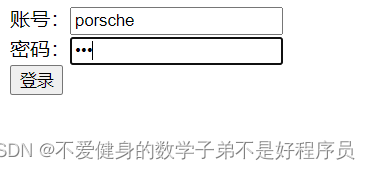
目录
一、登录验证
1.自定义密码账号
Ⅰ.引入依赖
先搭建好一个SpringBoot框架,在基础上引入依赖
<!--web-->
<dependency>
<groupId>org.springframework.boot</groupId>
<artifactId>spring-boot-starter-web</artifactId>
<version>2.7.1</version>
</dependency>
<!--小辣椒-->
<dependency>
<groupId>org.projectlombok</groupId>
<artifactId>lombok</artifactId>
<version>1.18.24</version>
</dependency>
<!--spring security-->
<dependency>
<groupId>org.springframework.boot</groupId>
<artifactId>spring-boot-starter-security</artifactId>
</dependency>Ⅱ. XxxApplication启动类
@SpringBootApplication
public class DemoApplication {
public static void main(String[] args) {
SpringApplication.run(DemoApplication.class,args);
}
}Ⅲ. 在application.yml文件中自定义
spring:
security:
user:
name: porsche
password: 911Ⅳ.启动项目
运行项目,在网页中输入账号密码。
2.从数据库中查找账号和密码
Ⅰ.引入依赖
<!--mysql连接-->
<dependency>
<groupId>mysql</groupId>
<artifactId>mysql-connector-java</artifactId>
</dependency>
<!--mybatis plus-->
<dependency>
<groupId>com.baomidou</groupId>
<artifactId>mybatis-plus-boot-starter</artifactId>
<version>3.5.1</version>
</dependency>
<!--druid-->
<dependency>
<groupId>com.alibaba</groupId>
<artifactId>druid-spring-boot-starter</artifactId>
<version>1.2.9</version>
</dependency>Ⅱ. application.yml文件
server:
port: 8080
spring:
datasource:
driver-class-name: com.mysql.cj.jdbc.Driver
username: bjwl
password: bjwl
url: jdbc:mysql://192.168.1.118:3306/book_store?serverTimezone=Asia/Shanghai&useSSL=false&allowPublicKeyRetrieval=true
type: com.alibaba.druid.pool.DruidDataSource
mybatis-plus:
configuration:
map-underscore-to-camel-case: false
log-impl: org.apache.ibatis.logging.stdout.StdOutImplⅢ. bean包的操作
实体类:
@Data
@AllArgsConstructor
@NoArgsConstructor
@TableName("user")
public class Users implements Serializable {
private Integer id;
private String userName;
private String passWord;
private String nickName;
private Integer state;
}
LoginUsers类:
@AllArgsConstructor
@NoArgsConstructor
public class LoginUsers implements UserDetails {
private Users users;
//返回当前用户的所有权限
public Collection<? extends GrantedAuthority> getAuthorities() {
return users.getList();
}
//返回密码
public String getPassword() {
return users.getPassWord();
}
//返回用户名
public String getUsername() {
return users.getUserName();
}
@Override
public boolean isAccountNonExpired() {
return true;
}
@Override
public boolean isAccountNonLocked() {
return true;
}
@Override
public boolean isCredentialsNonExpired() {
return true;
}
@Override
public boolean isEnabled() {
return true;
}
}
Ⅳ. service层
// 是SpringSecurity的业务类,负责实现认证和授权
@Service
public class UsersService implements UserDetailsService {
@Resource
private UsersMapper mapper;
@Override
public UserDetails loadUserByUsername(String username) throws UsernameNotFoundException {
QueryWrapper<Users> wrapper = new QueryWrapper<>();
wrapper.eq("username", username);
Users users = mapper.selectOne(wrapper);//查询一条记录
if (Objects.isNull(users)) {
throw new RuntimeException("用户名没有找到");
}
return new LoginUsers(users);
}
}Ⅴ.config配置类
/*
它是SpringSecurity的配置类
*/
@Configuration
public class SpringSecurityConfig extends WebSecurityConfigurerAdapter {
@Resource
private UsersService usersService;
@Bean
public PasswordEncoder getPasswordEncoder() {
return new BCryptPasswordEncoder();
}
//数据库的认证
protected void configure(AuthenticationManagerBuilder auth) throws Exception {
auth.userDetailsService(usersService).passwordEncoder(getPasswordEncoder());
}
}Ⅵ.启动项目

此时后台也会显示出,在数据库中查询了一次

二、权限问题
1.config类
在类中设置权限,和设置权限名,给1.html只开启了abc01的权限,给2.html开启了abc01和abc02的权限。
也就是说abc01可以访问1.html和2.html,abc02只可以访问2.html
protected void configure(HttpSecurity http) throws Exception {
http.formLogin()
.loginPage("/login.html") //登录页面设置
.loginProcessingUrl("/a/lo") //登录访问路径 这里同 login.html中的action
.permitAll()
.and().exceptionHandling().accessDeniedPage("/403.html")
.and().authorizeRequests()
.antMatchers("/login.html", "/a/lo").permitAll() //设置哪些路径可以直接访问,不需要认证
.antMatchers("/1.html").hasAuthority("adc01") //设置当前网页访问权限
.antMatchers("/2.html").hasAnyAuthority("abc01","abc02")
.anyRequest().authenticated() //所有请求都可以访问
.and().csrf().disable(); //关闭csrf,csrf:跨站请求伪造
}2.bean包
在实体类中加入
@TableField(exist = false)
private List<GrantedAuthority> list;3.service层
为用户设置权限名
List<GrantedAuthority> list = new ArrayList<>();
list.add(new SimpleGrantedAuthority("abc02"));
users.setList(list);4.启动项目
登录

访问1.html

访问2.html


